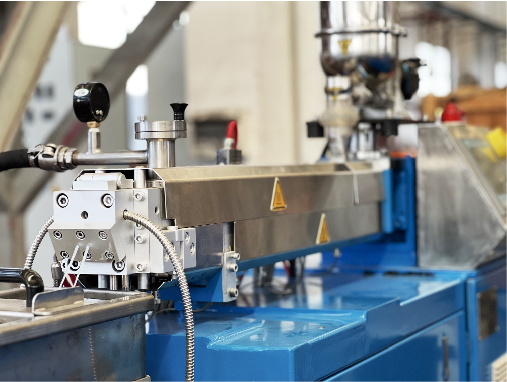
As the main equipment of compounding production, the extruder bears the brunt of its operation difficulty and danger. Today, we will sort out the little common sense you need to keep in mind during the operation and debugging of the extruder and start small to protect compounding extruder safety procedures.
Preliminary preparation
1. check machine and lubricate
Before starting the compounding extruder, check whether there is any foreign matter in the barrel, up and down the hopper, and inside, check whether the fastening bolts of each part are loose, whether the safety cover is firm, whether the position of each button switch is correct, and then lubricate each part. Add enough lubricating oil and do a good job of cleaning and sanitizing the equipment.
2. Temperature control testing
Before starting the machine, check whether the temperature control is sensitive, whether the instrument is out of order, and whether the cooling water circuit is smooth. Usually, methods such as thermometers and cooling water are used for detection.
Start the extruder
3. heating step
Follow the compounding extruder operating procedures to heat the screw, barrel, and die head. Once reaching the set temperature, maintain warmth for about 10 minutes before starting the machine to ensure temperature stability in all parts.
4. Notify staff before starting
Alert nearby staff when preparing to start the machine. Before starting, ensure all connecting screws and bolts of the die are tightened while it’s hot. Operators must avoid standing in front of the die before material extrusion to prevent injury from potential bolt or screw breakage.
5. Low-speed starting motor
Start the motor for driving the screw rotation at low speed, and check whether the pointer of the working ammeter of the main motor swings normally.
Feed production
6. Trial run
The test run of the screw should not exceed 30 minutes. Once everything is normal, connect the die head and pelletizing equipment. Install the die head bolts and apply molybdenum disulfide or silicone oil to facilitate disassembly.
7. Initial input
In the initial stage of feeding production, the screw should use the lowest working speed, and the feeding should be less and uniform. Check whether the pointer of the working ammeter of the motor used to drive the screw rotation changes at any time.
Downtime and maintenance
8. Temperature checks during production
During regular production, monitor bearing temperatures on the extruder. Use the back of your finger to touch motor and bearing parts for temperature checks gently. Avoid touching rotating parts during equipment operation.
9. Precautions for disassembly and assembly
When dismantling and installing the screw and mold, do not directly hit the parts with a heavy hammer, if necessary, pad hardwood and then tap to disassemble or install.
10. Clean up residue
Clean residual material from the screw, barrel, and mold with bamboo or copper knives, brushes, or specialized water and air washing equipment. Avoid using steel knives or fire. Alternatively, use special screw cleaning materials for cleaning without disassembly.
Attachment: 9 kinds of raw materials when the operation matters when downtime
| PS, SAN | Because the thermal stability of hard glue is good, it will not decompose even if it is heated for a long time at a certain temperature, so it is only necessary to turn off the heat before shutting down. |
|---|---|
| ABS | The thermal stability of this compound is also good, and there is no need to push out and clean the remaining compound in the barrel during shutdown. |
| PE | Due to the temporary suspension of production (such as the night shift does not start), it is necessary to keep the barrel at 160 °C to avoid the rubber material being damp. If the material needs to be changed, it is necessary to use PE to clean the barrel and take out the screw from the hot barrel. Use a copper wire brush cleaning screw. |
| PVC | This is a heat-sensitive rubber compound. Before stopping, first, turn off the electric heating, and then push out the PVC until the temperature of the barrel drops to 150°C, and then use another rubber compound with better thermal stability to push out all the rubber material in the barrel. |
| PMMA | Although the rubber compound is easily thermally decomposed at high temperatures, the thermal stability is still good at normal temperatures, so it is only necessary to turn off the electric heating when the machine is shut down. |
| PA | There is no need to clean the barrel or push the material clean when the machine is shut down, but the electric heating must be turned off immediately, otherwise the rubber compound will be easily damaged after 15 minutes. |
| POM | Because it is heat sensitive when the machine is shut down, the pressure should be zeroed ten minutes before the electric heater is turned off, and then a continuous injection, push out the rubber material in the barrel and then use PE to clean the machine. |
Troubleshooting and precautions
11. Troubleshooting
When dealing with the failure of the extruder, the extruder is not allowed to run. When the extruder screw is rotated and the mold is adjusted, the operator is not allowed to face the mouth of the extrusion barrel to prevent accidents.
12. Operator job responsibilities
When the extruder is in production, the operator is not allowed to leave the post. If it is necessary to leave, the extruder should be stopped.
13. Long-term downtime maintenance
Disassemble the screw after parking, and apply a layer of anti-rust oil after cleaning the residual material. If it is not used temporarily, it should be wrapped and hung vertically in a dry and ventilated place.
14. Anti-rust protection
For extruders and accessories that have been shut down for a long time, they should be coated with anti-rust oil and sealed to prevent foreign objects from entering.
Content source: PTOnline, Xintec Translation
Disclaimer: The data, charts, and content in this article are sourced from the Internet or publicly published materials. They are for reference, communication, and learning only, with no commercial intent. Copyright belongs to the original authors and sources. If any copyright owner believes this article infringes on their rights, please contact us for timely resolution.

